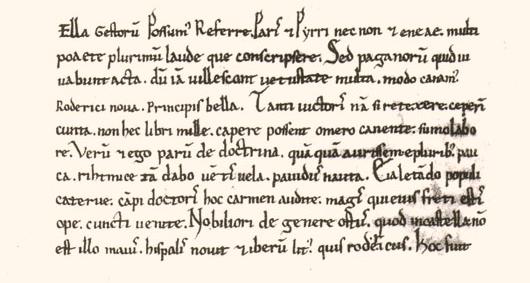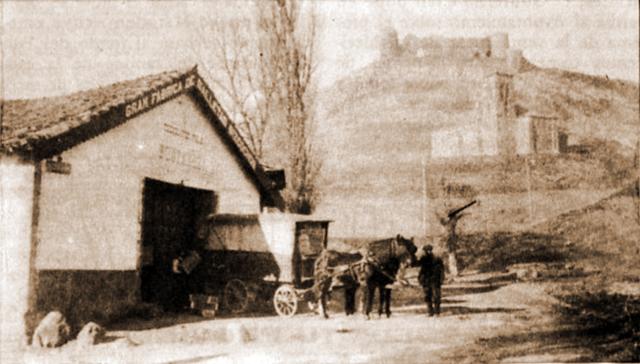|
Rodrigo González De Lara
Rodrigo González de Lara (''floruit'' 1078–1143) was a Kingdom of Castile, Castilian nobleman of the House of Lara. Early in his career he ruled that half of Asturias allocated to Castile. He was faithful to the crown throughout the reign of Urraca of León and Castile, Queen Urraca (1109–26), during which time he was married to the queen's half-sister and ruled a large part of the old County of Castile. He and his elder brother, Pedro González de Lara, Pedro González, led the opposition to Alfonso VII early in his reign (1126–57). He led a revolt in 1130 and was exiled in 1137. He was a leader in the ''Reconquista''—about which the contemporary ''Chronica Adefonsi imperatoris'' has much to say—and also took part in the Military history of the Crusader states, military activities of the Crusader states on two occasions. He travelled widely throughout Spain, but ended his days in Palestine. Youth under Alfonso VI (1078–1112) Rodrigo was a son of Gonzalo Núñez de La ... [...More Info...] [...Related Items...] OR: [Wikipedia] [Google] [Baidu] |
El Cid
Rodrigo Díaz de Vivar ( – 10 July 1099) was a Castilian knight and ruler in medieval Spain. Fighting both with Christian and Muslim armies during his lifetime, he earned the Arabic honorific ("the Lord" or "the Master"), which would evolve into El Çid (, ), and the Spanish honorific El Campeador ("the Champion"). He was born in Vivar del Cid, Vivar, a village near the city of Burgos. As the head of his loyal knights, he came to dominate the Levante, Spain, Levante of the Iberian Peninsula at the end of the 11th century. He reclaimed the Taifa of Valencia from Moorish control for a brief period during the ''Reconquista'', ruling the Lordship of Valencia, Principality of Valencia from 17 June 1094 until his death in 1099. His wife, Jimena Díaz, inherited the city and maintained it until 1102 when it was reconquered by the Moors. Díaz de Vivar became well known for his service in the armies of both Christian and Muslim rulers. After his death, El Cid became Spain's most cel ... [...More Info...] [...Related Items...] OR: [Wikipedia] [Google] [Baidu] |
Kingdom Of León
The Kingdom of León was an independent kingdom situated in the northwest region of the Iberian Peninsula. It was founded in 910 when the Christian princes of Kingdom of Asturias, Asturias along the Bay of Biscay, northern coast of the peninsula shifted their capital from Oviedo to the city of León, Spain, León. The List of Leonese monarchs, kings of León fought civil wars, wars against neighbouring kingdoms, and campaigns to repel invasions by both the Moors and the Vikings, all in order to protect their kingdom's changing fortunes. García I of León, García is the first of the kings described by the charters as reigning in León. It is generally assumed that the old Asturian kingdom was divided among the three sons of Alfonso III of Asturias: García (León), Ordoño II of León, Ordoño (Galicia (Spain), Galicia) and Fruela II of Asturias, Fruela (Asturias), as all three participated in deposing their father. When García died in 914, León went to Ordoño, who now ruled ... [...More Info...] [...Related Items...] OR: [Wikipedia] [Google] [Baidu] |
Benedictine
The Benedictines, officially the Order of Saint Benedict (, abbreviated as O.S.B. or OSB), are a mainly contemplative monastic order of the Catholic Church for men and for women who follow the Rule of Saint Benedict. Initiated in 529, they are the oldest of all the religious orders in the Latin Church. The male religious are also sometimes called the Black Monks, especially in English speaking countries, after the colour of their habits, although some, like the Olivetans, wear white. They were founded by Benedict of Nursia, a 6th-century Italian monk who laid the foundations of Benedictine monasticism through the formulation of his Rule. Benedict's sister, Scholastica, possibly his twin, also became a religious from an early age, but chose to live as a hermit. They retained a close relationship until her death. Despite being called an order, the Benedictines do not operate under a single hierarchy. They are instead organized as a collection of autonomous monasteries ... [...More Info...] [...Related Items...] OR: [Wikipedia] [Google] [Baidu] |
Count
Count (feminine: countess) is a historical title of nobility in certain European countries, varying in relative status, generally of middling rank in the hierarchy of nobility. Pine, L. G. ''Titles: How the King Became His Majesty''. New York: Barnes & Noble, 1992. p. 73. . Especially in earlier medieval periods the term often implied not only a certain status, but also that the ''count'' had specific responsibilities or offices. The etymologically related English term " county" denoted the territories associated with some countships, but not all. The title of ''count'' is typically not used in England or English-speaking countries, and the term ''earl'' is used instead. A female holder of the title is still referred to as a ''countess'', however. Origin of the term The word ''count'' came into English from the French ', itself from Latin '—in its accusative form ''comitem''. It meant "companion" or "attendant", and as a title it indicated that someone was delegated to ... [...More Info...] [...Related Items...] OR: [Wikipedia] [Google] [Baidu] |
Castilla La Vieja
Old Castile ( ) is a historic region of Spain, which had different definitions across the centuries. Its extension was formally defined in the 1833 territorial division of Spain as the sum of the following provinces: Santander (now Cantabria), Burgos (province), Burgos, Logroño (now La Rioja (autonomous community), La Rioja), Soria (province), Soria, Segovia (province), Segovia, Ávila (province), Ávila, Valladolid (province), Valladolid and Palencia (province), Palencia. As the rest of ''regions'' in that division, Old Castile never had any special administrative agency; only the individual provinces had their own management. The name ''Old Castile'' reflects the fact that this territory corresponds very roughly to the extension of the Kingdom of Castile around the 11th century, before it expanded to the south. This kingdom had its origins in the 9th century in an area now comprising Cantabria, Álava, and Burgos province. In the 18th century, Charles III of Spain assigne ... [...More Info...] [...Related Items...] OR: [Wikipedia] [Google] [Baidu] |
Aguilar De Campoo
Aguilar de Campoo () is a town and municipalities in Spain, municipality of Spain located in the North of province of Palencia, autonomous community of Castile and León. The River Pisuerga flows through its historic centre. Its 2011 population was 7741. It is one of the locations of the Camino de Santiago, St. James' Northern Way (Ruta del Besaya). Since 2017, the municipality has been included in the Geopark of Las Loras, the first UNESCO Geopark in Castile and León. History In May 1255 Alfonso X the Wise granted Aguilar a royal fuero, and thus the town also became a ''realengo'' ('royal demesne'). The town maintained that status until 1332. The town featured a seizeable Jewish community in the middle ages. Gullón and Fontaneda opened biscuit factories in 1904 and 1913, respectively, and the town acquired a reputation as a renowned biscuit-making centre in Spain in the 20th century. In medieval times, Aguilar de Campoo was home to a Jewish community. The earliest documentati ... [...More Info...] [...Related Items...] OR: [Wikipedia] [Google] [Baidu] |
Trasmiera
Trasmiera (Spanish: ''Trasmiera''; Cantabrian and historically: ''Tresmiera'') is a historic ''comarca'' of Cantabria (Spain), located to the east of the Miera River (''tras'' Miera, meaning behind Miera, from the point of view of Asturias de Santillana), reaching the western side of the Asón. It extends between the bays of Santander and Santoña, occupying most of the Eastern seaboard of Cantabria. This piece of coast is known for its cliffs and fine beaches, such as those of Langre, Loredo, Isla, Noja and Berria. Towards the interior, the ''comarca'' offers large prairies as well as considerable hotel and camping development. Municipalities Trasmiera is composed of the 19 municipalities of Argoños, Arnuero, Bárcena de Cicero, Bareyo, Entrambasaguas, Escalante, Hazas de Cesto, Liérganes, Marina de Cudeyo, Medio Cudeyo, Meruelo, Miera, Noja, Ribamontán al Mar, Ribamontán al Monte, Riotuerto, Santoña, Solórzano and Voto. Their areas and populations ar ... [...More Info...] [...Related Items...] OR: [Wikipedia] [Google] [Baidu] |
Rodrigo Muñoz (count)
Rodrigo Martín Muñoz Salomón (; born 22 January 1982) is a Uruguayan former footballer who played as a goalkeeper. Club career Cerro Muñoz played for Cerro from 2002 to 2008, scoring 4 goals. Nacional In 2009, he was transferred to Club Nacional de Football, making his debut in a 2-1 home win against Universidad San Martín de Porres in the 2009 Copa Libertadores on February 12, 2009. With Nacional he won the Uruguayan championship twice (2009 & 2011). Libertad In January 2012, he signed a new deal with the Paraguayan side Libertad. International career On 18 May 2011 he was reserved to play a friendly match against Germany in Sinsheim. Muñoz was named in Uruguay's provisional squad for Copa América Centenario but was cut from the final squad. Honours ;Nacional *Uruguayan Primera División The Liga Profesional de Primera División (American Spanish , , local: , ''First Division''), named "Torneo Uruguayo Copa Coca-Cola" for sponsorship reasons, is the highest p ... [...More Info...] [...Related Items...] OR: [Wikipedia] [Google] [Baidu] |
Asturias De Santillana
Asturias de Santillana is a historical ''comarca'' whose territory in large part corresponded to the central and western part of today's autonomous community of Cantabria, as well as the extreme east of Asturias. Most of the province of Asturias belonged to the ''comarca'' of Asturias de Oviedo. Also known also as a ''merindad'' and documented since the 13th century, Asturias de Santillana comprised the western part of Cantabria (except Liébana which belongs to another ''comarca'') including the Saja River valley and the Nansa River. Its borders used to go along the coast from the council of Ribadedeva to the municipality of El Astillero (old Camargo Valley), to the shores of the Bay of Santander), which leads to the administrative division of Trasmiera. From the south it went up to the Cantabrian cordillera. All of the valleys of this ''comarca'' are perpendicular to the coast. The ''merinos'' were representatives of the king and they lived in this administrative division ... [...More Info...] [...Related Items...] OR: [Wikipedia] [Google] [Baidu] |
Valle De Mena
The Mena Valley () is a municipality in the province of Burgos in Spain. It is located in the autonomous community of Castile and León, bordering the provinces of Alava, Biscay and Cantabria Cantabria (, ; ) is an autonomous community and Provinces of Spain, province in northern Spain with Santander, Cantabria, Santander as its capital city. It is called a , a Nationalities and regions of Spain, historic community, in its current .... The Mena valley has 4,096 inhabitants distributed among 43 small villages. Its capital, Villasana de Mena, has 1,554 inhabitants. Monuments * Church of San Lorenzo de Vallejo de Mena, Burgos * Church of Santa Maria de Siones, Burgos References Municipalities in the Province of Burgos {{Burgos-geo-stub ... [...More Info...] [...Related Items...] OR: [Wikipedia] [Google] [Baidu] |





